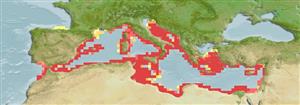Common names from other countries
Пластиножаберные (акулы и скаты) (sharks and rays) >
Rajiformes (Skates and rays) >
Rajidae (Skates)
Etymology: Raja: Latin, raja, -ae = a sting ray (Raja sp.) (Ref. 45335).
Environment: milieu / climate zone / depth range / distribution range
экология
морской демерсальный; пределы глубины ? - 300 m (Ref. 4426). Subtropical; 46°N - 30°N, 8°W - 36°E
Eastern Atlantic: known only from the Mediterranean but may penetrate through the Strait of Gibraltar and possibly to northern Morocco. Some Atlantic records probably misidentifications of Raja naevus and/or Raja africana.
Size / Вес / Возраст
Maturity: Lm ? range ? - ? cm
Max length : 70.0 cm TL самец/пол неопределен; (Ref. 4426)
Range from coastal waters to about 300 m depth (Ref. 3167). Feed on all kinds of bottom animals (Ref. 3167). Oviparous. Distinct pairing with embrace. Young may tend to follow large objects, such as their mother (Ref. 205). Eggs are oblong capsules with stiff pointed horns at the corners deposited in sandy or muddy flats (Ref. 205). About 80-154 eggs are laid by an individual in a year (Ref. 41305).
Life cycle and mating behavior
Maturities | размножение | Spawnings | Egg(s) | Fecundities | личинки
Oviparous, paired eggs are laid. Embryos feed solely on yolk (Ref. 50449). Spawns throughout the year with maximum number of egg-cases laid in late spring and summer, embryos developing in about 4 months (Ref. 3167). Distinct pairing with embrace. Young may tend to follow large objects, such as their mother (Ref. 205).
McEachran, J.D. and K.A. Dunn, 1998. Phylogenetic analysis of skates, a morphologically conservative clade of elasmobranchs (Chondrichthyes: Rajidae). Copeia 1998(2):271-290. (Ref. 27314)
Статус Красного Списка МСОП (Ref. 130435)
CITES (Ref. 128078)
Not Evaluated
Угроза для людей
Harmless
Использование человеком
рыболовство: коммерческий
дополнительная информация
инструменты
Специальные отчеты
Скачать в формате XML
ресурсы в Интернет
Estimates based on models
Preferred temperature (Ref.
115969): 13.4 - 18.4, mean 15 (based on 128 cells).
Phylogenetic diversity index (Ref.
82804): PD
50 = 0.5000 [Uniqueness, from 0.5 = low to 2.0 = high].
Bayesian length-weight: a=0.00331 (0.00209 - 0.00525), b=3.20 (3.07 - 3.33), in cm Total Length, based on LWR estimates for this species & Genus-body shape (Ref.
93245).
Trophic level (Ref.
69278): 3.7 ±0.54 se; based on food items.
устойчивость к внешним воздействиям (Ref.
120179): низкий, минимальное время удвоения популяции 4.5-14 лет (Fec=80).
Fishing Vulnerability (Ref.
59153): Moderate to high vulnerability (48 of 100).
